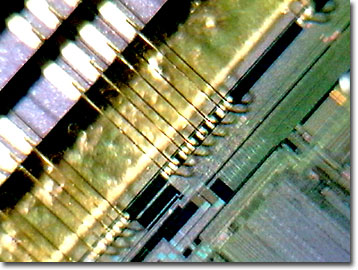Integrated Circuit Image Gallery
Intel i960 Embedded Microprocessor
Many consumers know Intel as the company making the processors inside their personal computers. However, Intel's i960 line of microprocessors, featuring a reduced instruction set computing (RISC) specification, provides the "brains" for a vast array of other products. Among these are the then-popular (circa 1995) Daytona arcade racing game from Sega, the best-selling Hewlett-Packard LaserJet 4 series printers, video poker machines used in casinos around the world, and early hand-held global positioning satellite (GPS) systems that oriented outdoor enthusiasts, the military, and rescue personnel to exact locations.

View a second image of an Intel i960 processor.
The i960, first released in 1988, featured 250,000 transistors installed on a silicon die using 1.5-micron technology. There are six families of embedded 32-bit RISC-specified chips in this large group, including the super-scalar i960 CXs. In 1992, the CA processor was released as the world's first super-scalar 32-bit processor developed for embedded applications.
With a throughput of 66 native millions of instructions per second (MIPS), the i960 CA Cobra doubled the performance goals set for the line of microprocessors. Adding an advanced design in 1994 with one-Kbyte secondary memory cache onboard, the CF version is capable of doubling the performance of the CA processor in many applications. The CX CPUs are socket-compatible, allowing quick design upgrades and are object-code-compatible with all i960-architecture family members.
Built with 0.8-micron, two-layer complementary high-density metal oxide semiconductor (CHMOS) technology, the CA places 600,000 transistors on a 143-square-millimeter die. The even higher-density, more advanced CF version features 900,000 transistors on 125 square millimeters of silicon. Cobra CXs feature on-chip 1-Kbyte (data) random access memory and instruction caches ranging from 1 Kbyte (CA) to 4 Kbytes (CF). Both models feature clock speeds of 16, 20, and 33 MHz with the speedier CF adding a 40 MHz-clocked version. The processors are available in either a 168-pin ceramic pin-grid array (PGA) or 196-pin plastic quad flat pack (PQFP) packages for different applications. As with other Intel products, the "i" on the chip signifies that it was directly manufactured by Intel and not one of its license holders.
Contributing Authors
Omar Alvarado, Thomas J. Fellers and Michael W. Davidson - National High Magnetic Field Laboratory, 1800 East Paul Dirac Dr., The Florida State University, Tallahassee, Florida, 32310.
BACK TO THE INTEGRATED CIRCUIT IMAGE GALLERY
BACK TO THE DIGITAL IMAGE GALLERIES
Questions or comments? Send us an email.
© 1995-2025 by Michael W. Davidson and The Florida State University. All Rights Reserved. No images, graphics, software, scripts, or applets may be reproduced or used in any manner without permission from the copyright holders. Use of this website means you agree to all of the Legal Terms and Conditions set forth by the owners.
This website is maintained by our
Graphics & Web Programming Team
in collaboration with Optical Microscopy at the
National High Magnetic Field Laboratory.
Last Modification Friday, Nov 13, 2015 at 01:19 PM
Access Count Since September 17, 2002: 10133
Visit the website of our partner in introductory microscopy education:
|
|
